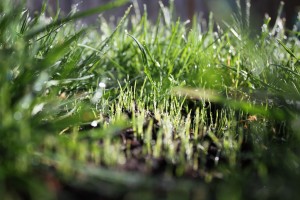Lawn looking a little thin? Need to fix bald spots and other damage left behind by winter weather? Maybe now is a good time to consider overseeding. By choosing the right grass and doing the right preparation, you can get your lawn looking lush and green again.
Choosing a Grass
Grass seed is available in mixes with one predominant variety. Choosing the right one depends on where you live and where it will be applied.
Northeast: Kentucky bluegrass
Kentucky bluegrass works well in cool climates and is disease resistant, making it a natural fit.
Southeast: Bermudagrass
This grass is heat resistant and works well in high moisture areas.
Midwest: Kentucky bluegrass and fescue
A milder climate in the summer lets both of these grasses thrive.
Gulf Coast: Bahiagrass, centipede grass, Bermudagrass
Centipede grass is good for poor nutrient soil, while bahiagrass is pest and disease resistant.
West: Tall Fescue
This grass is drought resistant, making it a good choice for areas with a mix of rainy and dry periods.
Pacific Northwest: Kentucky bluegrass and tall fescue
Both of these grasses can handle heavy rainfall.
Southwest: Bermudagrass
This grass needs 40% less moisture than fescue, making it a good choice for dry areas.
Transition region: Kentucky bluegrass, tall fescue, and zoysia
This region includes the central states between the East coast and Kansas, where weather can be unpredictable. Unlike modern varieties, standard zoysia works well in summer and can survive surprise spring freezes.
If you’re planting in a shaded area, consider a shade tolerant Kentucky blue or a tall fescue. Tall fescue grows faster than turf fescue, so mixing these grasses will result in an uneven lawn.
Endophytes are a type of fungi that grow on grass, making it unpalatable to insects and more resistant to heat stress, red thread, and dollar spot. Endophyte-enhanced seeds are a good choice for areas with major heat and pest problems, but it can make grazing animals severely ill. If there is any chance that horses or cows might get on your lawn, this type of seed should be avoided.
When to Seed
Temperatures need to be between 59 and 77 degrees to get the seeds to germinate, and there needs to be little to no chance of getting snow or heavy freeze.
Preparing the Soil
Get a soil test. While there are fertilizer blends designed for spring seed germination, they might not be the mix your soil needs to support growth. Strong phosphorus (P) levels are needed to encourage grass growth. If you’re going to apply fertilizer, do so before overseeding.
If you need to use pre-emergent herbicides, put them down a few weeks before you plan on overseeding. Otherwise, they could keep the new seeds from germinating.
Aerating the soil will break compacted areas, and it helps new seeds penetrate the soil while having plenty of access to air and water. If you aren’t going to aerate, consider adding a light top dress of soil after seeding to help the new plants take root.
Dethatching may be necessary if you have buildup that’ s over a half inch thick. Like aeration, this helps open up the soil to give the seeds a better chance of taking root.
Mow the grass to a height of two inches or less. This helps seeds spread by your overseeder land directly on the soil.
Overseeding
If you haven’t overseeded before or you need to cover a bald spot, go for the maximum amount on the package. If you have overseeded, aim for the middle or low recommendations, depending on the current grass density on your lawn. Expect to use at least 5 lbs. per 1,000 square feet of soil. The lid of your overseeder will have instructions for setting the correct drop rate.
The overseeder should move at a good walking pace. The OS500 may not have a drive system, but the blades will help pull it along as it cuts slots into the turf for the seeds.
Getting the New Grass to Take Hold
Bald spots should be covered with straw or a thin layer of soil to protect the grass from direct sunlight.
Lightly water the soil two to three times a day. The soil should be moist, not muddy. Once the new grass starts sprouting, decrease the watering frequency, but increase the amount to let the water penetrate deeper into the soil. Once the new grass is two inches tall, you can resume normal mowing and watering.
Getting Parts for Billy Goat Overseeders and Dethatchers
Need to work on your overseeder? Is your power rake due for some new tines? www.billygoatparts.com is a certified dealer for Billy Goat and their manufacturing partners, making us your one-stop shop for parts and accessories for their equipment. Our site lets you find parts based on your model and can show you factory parts diagrams and descriptions so you can be sure you’re getting what you need. We can ship your order to any address in the U.S. or Canada.

